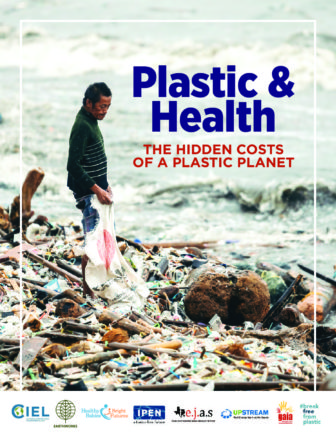Despite being one of the most pervasive materials on the planet, plastic and its impact on human health is poorly understood. Yet exposure to plastic are expanding into new areas of the environment and food chain as existing plastic products fragment into smaller particles and concentrate toxic chemicals.
Key Findings
Plastic requires a lifecycle approach. The narrow approaches to assessing and addressing plastic impacts to date are inadequate and inappropriate. Understanding and responding to plastic risks, and making informed decisions in the face of those risks, demands a full lifecycle approach to assessing the full scope of the impacts of plastic on human health. This includes to ensure that we are not creating yet more and increasingly complex environmental problems in attempts to address this one.
At every stage of its lifecycle, plastic poses distinct risks to human health, arising from both exposure to plastic particles themselves and associated chemicals. The majority of people worldwide are exposed at multiple stages of this lifecycle.
- Extraction and Transport of Fossil Feedstocks for Plastic
The extraction of oil and gas, particularly the use of hydraulic fracturing for natural gas, releases an array of toxic substances into the air and water, often in significant volumes. Over 170 fracking chemicals that are used to produce the main feedstocks for plastic have known human health impacts, including cancer, neurotoxicity, reproductive and develop- mental toxicity, impairment of the immune system, and more. These toxins have direct and documented impacts on skin, eyes, and other sensory organs, the respiratory, nervous, and gastrointestinal systems, liver, and brain. - Refining and Production of Plastic Resins and Additives
Transforming fossil fuel into plastic resins and additives releases carcinogenic and other highly toxic substances into the air. Documented effects of exposure to these substances include impairment of the nervous system, reproductive and developmental problems, cancer, leukemia, and genetic impacts like low birth weight. Industry workers and communities neighboring refining facilities are at greatest risk and face both chronic exposures and acute exposures due to uncontrolled releases during emergencies. - Consumer Products and Packaging
Use of plastic products leads to ingestion and/ or inhalation of large amounts of both micro- plastic particles and hundreds of toxic sub- stances with carcinogenic, developmental, or endocrine disrupting impacts. - Toxic Releases from Plastic Waste Management
All plastic waste management technologies (including incineration, co-incineration, gasification, and pyrolysis) result in the release of toxic metals such as lead and mercury, organic substances (dioxins and furans), acid gases, and other toxic substances to the air, water, and soils. All such technologies lead to direct and indirect exposure to toxic substances for workers and nearby communities, including through inhalation of contaminated air, direct contact with contaminated soil or water, and ingestion of foods that were grown in an environment polluted with these substances. Toxins from emissions, fly ash, and slag in a burn pile can travel long distances and deposit in soil and water, eventually entering human bodies after being accumulated in the tissues of plants and animals. - Fragmenting and Microplastics
Microplastics entering the human body via direct exposures through contact, ingestion, or inhalation can lead to an array of health impacts, including inflammation, genotoxicity, oxidative stress, apoptosis, and necrosis, which are linked to an array of negative health out- comes including cancer, cardiovascular diseases, inflammatory bowel disease, diabetes, rheumatoid arthritis, chronic inflammation, auto- immune conditions, neurodegenerative diseases, and stroke. - Cascading Exposure as Plastic Degrades
Most plastic additives are not bound to the polymer matrix and easily leach into the surrounding environment, including air, water, food, or body tissues. As plastic particles continue to degrade, new surface areas are exposed, allowing continued leaching of additives from the core to the surface of the particle in the environment and the human body. - Ongoing Environmental Exposures
Once plastic reaches the environment in the form of macro- or microplastics, it contaminates and accumulates in food chains through agricultural soils, terrestrial and aquatic food chains, and the water supply. This environmental plastic can leach toxic additives or concentrate toxins already in the environment, making them bioavailable again for direct or indirect human exposure.


